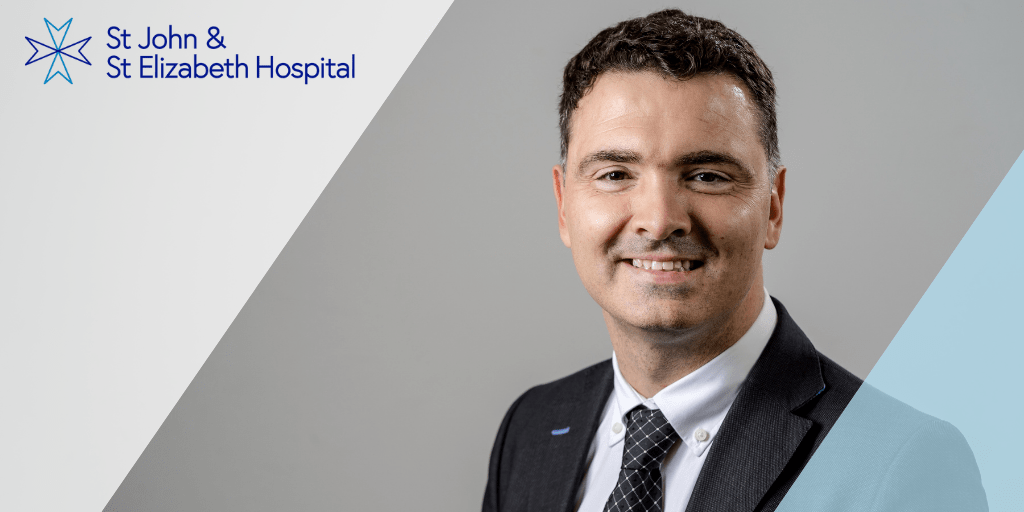How to avoid common bench press injuries
Read time: 5 mins

Mr Dimitrios Tsekes, leading Orthopaedic and Upper-Limb Surgeon at St John and St Elizabeth Hospital’s acclaimed Shoulder Unit looks at common injuries from the bench press exercise and how to avoid painful tendon tears.
Bench pressing is a standard weight-lifting exercise that features in most work-out routines at the gym or, as we have found during the COVID-19 pandemic, in our homes. It is one of the most effective ways of developing a well-built chest, significantly improving posture and physique.
But, without appropriate warm ups, correct technique and previous strengthening of specific shoulder’s muscle groups, it is a hot zone for injuries to the rotator cuff, the glenoid labrum and the pectoralis major muscle (pecs).
Damage caused by bench press injuries can take up to six weeks to heal, which is why it is so important to warm-up, develop good technique and aim for steady muscle building rather than looking for rapid changes and putting yourself at risk of injury.
Mr Tsekes details his golden rules for achieving good form, good technique and avoiding injuries. Without due care and attention you are risking suffering the consequences of poor technique and putting muscle groups under intense stress.
Common bench press injuries
One of the most common sites of injury is the rotator cuff, a system of four muscles and the tendons that surround our main shoulder joint. Their function is to move the shoulders and stabilise the joint but the rotator cuff tendons are unfortunately the weak link in our shoulder and without appropriate warm-up, stretching and build up, they can get inflamed (subacromial bursitis) or tear.
A subacromial bursitis is when there is pressure on the bursa of the shoulder (a sack of fluid that decreases rubbing and friction in our shoulder during movement), that causes it to erode, increasing friction and rubbing on muscles.
A torn rotator cuff is a serious injury caused by overloading weights and it needs immediate help from a medical professional. We often treat injuries to the pectoralis major muscles (pecs) that get overloaded during bench pressing.
Another common injury is a glenoid labral tear which impacts the soft tissue cuff that surrounds the shoulder socket.
What symptoms should I look out for?
Signs and symptoms of injuries include pain in the arm and shoulder, which varies depending on the severity of the tear. You may experience tenderness or weakness, unusual “crackling” or “grinding” noises, uncomfortableness and an inability to sleep on the shoulder, or exercise full range of motion and in the case of pec tear, sometimes there will be a visible cosmetic deformity in the chest wall.
How can bench press injuries be treated?
Treatments for rotator cuff injuries include anti-inflammatory medication, injections, ice, physiotherapy for minor injuries and can graduate to arthroscopic shoulder surgery, if symptoms persist. But, if you suspected a tear, it is advisable to consult an upper limb specialist who may explore operative and non-operative treatment options.
Average recovery time
It may take up to six weeks for the tendons or tissues to heal and up to three months of movement and strengthening for an operated shoulder to rehabilitate. When it does, patients usually enjoy a full range of motion and near-normal arm strength.
Mr Dimitrios’ golden rules of bench pressing
-
Warm up and stretch
Warm up for a good five minutes on a bike or treadmill before you start stretching. Then, stretch your arms for another five minutes before and after exercising, especially the muscles you are about to train; the rotator cuff muscles, the scapula (shoulder blade), stabilisers, the triceps and the pecs. This will help you with greater flexibility.
-
Take it slowly
Build up your activity level gradually so that your muscles, tendons and joints can cope.
-
Watch the reps
The more repetitions you do and the more force you use, the greater the chances for an injury. Listen to your body and stop if you feel any unusual pain.
-
Concentrate on posture
Good posture is key to a safe and effective bench press so ask your coach or trainer to teach you the correct techniques for bench pressing to reduce the stress and compression on the rotator cuff, scapular stabilisers and across the shoulder complex.
Five top tips to achieve good technique and avoid brench press injury
- Keep your shoulder blades retracted (braced) throughout
- Avoid bench-pressing with your back flat, rather maintain an arch in your back by bracing your shoulder blades and elevating the chest
- Touch the bar on your chest in line with your nipples and no higher up
- The movement of the bar should be a curved motion rather than a straight “up and down” motion
- Your elbows should remain firmly under the bar throughout the exercise with controlled and slow repetitions.
If you do experience injuries, St John & St Elizabeth’s Shoulder Unit is an ideal place to seek help to get you back to full health.
The Shoulder Unit provides a fully comprehensive service for all upper-limb injuries. All patients will be seen by a leading Orthopaedic Consultant specialised in treating all conditions obtained by the upper-limb and shoulder. From a consultation to examination and expert treatment we work closely with our specialist Physiotherapists for advanced, convenient and quick rehabilitation.
Do you have any chest or shoulder discomfort? Get in touch with our team.
Mr Dimitrios Tsekes is one of seven specialist upper-limb orthopaedic surgeons based at St John & St Elizabeth Hospital’s Shoulder Unit.
Medically reviewed by Mr Dimitrios Tsekes - FRCS(orth) FEBOT MSc
Posted on: 11 January 2024
Tags:
Content provided by Mr Dimitrios Tsekes - FRCS(orth) FEBOT MSc
